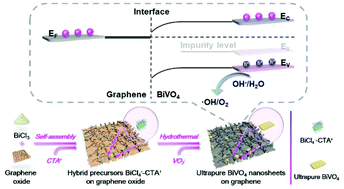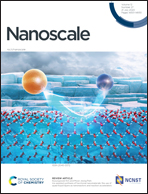In situ modification of BiVO4 nanosheets on graphene for boosting photocatalytic water oxidation†
Abstract
Owing to the sluggish water oxidation process, unearthing an ideal model for disclosing the impact of an architectural approach on the water oxidation activity of photocatalysts becomes a vital issue. Here, we propose an innovative in situ modification strategy for constructing ultrapure BiVO4 nanosheets on graphene (u-BVG) toward the accelerated photocatalytic water oxidation reaction. Considering the Mott–Schottky heterojunctions at the contact interface in u-BVG, the feasible electron transfer from excited BiVO4 to graphene facilitates the holes to migrate onto the BiVO4 surface for the water oxidation reaction. Compared with the conventional synthesis strategies, our strategy avoids the introduction of Cl impurities. This modification allows for not only a ca. 0.1 eV deeper valence band edge position to generate holes with a stronger oxidation potential but the extraction of the impurity level to suppress the carrier recombination. And density functional theory calculations are in accordance with the above results. Impressively, these merits endow the u-BVG with ca. 16.8 times growth in the amount of ˙OH radicals derived from OH−/H2O oxidation, an over 260% enhancement in O2 yield and a 1.6-fold increase in the apparent quantum efficiency relative to the impure counterpart. This work paves the way for the reconstruction of graphene-based binary systems with high performance in solar-to-chemical energy conversion.



 Please wait while we load your content...
Please wait while we load your content...